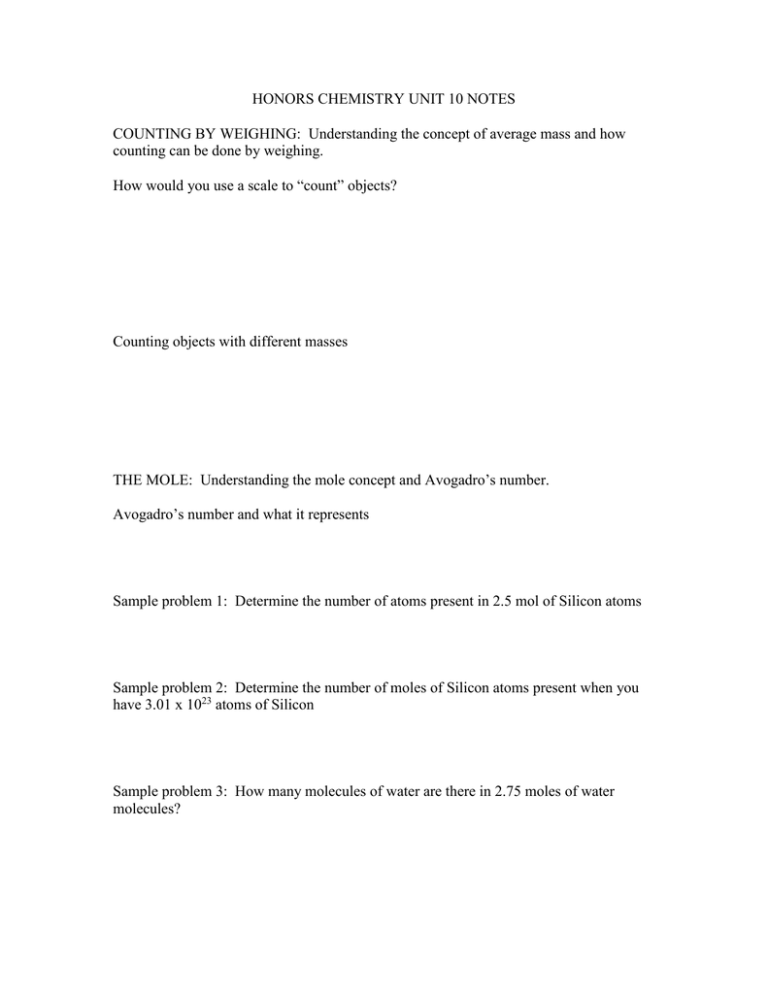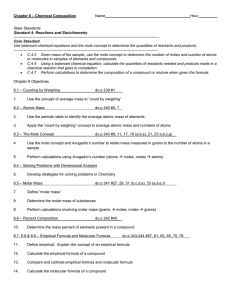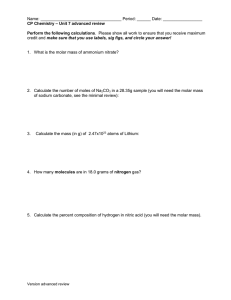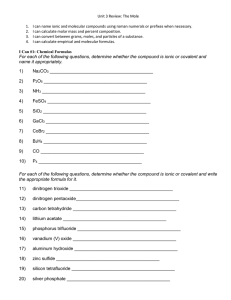File - wilson science WEBSITE
advertisement

HONORS CHEMISTRY UNIT 10 NOTES COUNTING BY WEIGHING: Understanding the concept of average mass and how counting can be done by weighing. How would you use a scale to “count” objects? Counting objects with different masses THE MOLE: Understanding the mole concept and Avogadro’s number. Avogadro’s number and what it represents Sample problem 1: Determine the number of atoms present in 2.5 mol of Silicon atoms Sample problem 2: Determine the number of moles of Silicon atoms present when you have 3.01 x 1023 atoms of Silicon Sample problem 3: How many molecules of water are there in 2.75 moles of water molecules? Sample problem 4: How many moles of calcium sulfate are there in 6.65 formula units of calcium sulfate? Using average atomic masses to calculate grams and moles: molar masses Sample problem 5: Determine the mass in grams of 3.50 mol of copper atoms Sample problem 6: Determine the number of moles of copper atoms present in 237 g of copper atoms What do molar mass and Avogadro’s constant have in common? Sample problem 7: How many atoms of calcium are present in 36.5 g of Ca atoms Sample problem 8: How many g of aluminum atoms are present in 2.36 x 1023 atoms of Al? Average atomic mass: How is it calculated and what is an amu? Sample problem 9: Cu-63 has an atomic mass of 62.94 amu with an abundance of 69.17%. Cu-65 has an atomic mass of 64.93 amu with an abundance of 30.83%. What is the average atomic mass of copper? Sample problem 10: Calculate the average atomic mass for silicon if 92.21% have a mass of 27.98 amu, 4.70% have a mass of 28.98 amu and 3.09% have a mass of 29.97 amu. The average mass of a single atom: How to calculate. Sample problem 11: What is the average mass of a single atom of silicon? Sample problem 12: What is the average mass of a single atom of He? MOLAR MASS: Converting between mass and moles of a given sample of a compound Formulas reveal a composition What is molar mass of a compound? Sample problem 13: Calculate the molar mass of sodium chloride Sample problem 14: Calculate the molar mass of barium nitrate Sample problem 15: Calculate the molar mass of C3H8O3 Calculating mass from moles and vice versa Sample problem 16: How many grams of sodium chloride are present in 3.40 moles of calcium chloride? Sample problem 17: How many moles of barium nitrate are present in 234.6 g of barium nitrate? Challenge: How many molecules of glucose (C6H12O6) are present in 1 serving of licorice if it contains 15 g of glucose? PERCENT COMPOSITION OF COMPOUNDS Review: What does the formula tell us? Finding Percent composition by mass percent Sample problem 18: Calculate the percent composition by mass of copper (I) sulfide Sample problem 19: Calculate the percent composition by mass of calcium sulfate CALCULATING EMPIRICAL FORMULAS What is an empirical formula? Sample problem 20: A compound is composed of 63.0% Manganese and 37.0% oxygen by mass. Determine the empirical formula of the compound Sample problem 21: Chemical analysis of a clear liquid shows that it is 60.0% C, 13.4% H and 26.6% O. Calculate the empirical formula of this substance. Sample problem 22: An oxide of aluminum is formed by the reaction of 4.151 g of aluminum with 3.692 g of oxygen. Calculate the empirical formula for this compound. Challenge problem: When 0.3456 g of vanadium metal is heated in air, it reacts with oxygen to achieve a final mass of 0.6330 g. Calculate the empirical formula of this oxide of vanadium. CALCULATING MOLECULAR FORMULAS What is a molecular formula? Is the molecular formula always different from the empirical formula? Sample problem 23: The empirical formula of a compound is found to be P2O5. The molar mass of the compound is 284 g/mol. Determine the molecular formula of the compound. Sample problem 24: Determine the molecular formula of a compound having an empirical formula of CH and a molar mass of 78 g/mol Sample problem 25: Oleic acid has the following composition: 75.54% C, 12.13% H, and 11.33% O. If the experimental molar mass is 282 g/mol, what are the empirical and molecular formulas for oleic acid? HYDRATES Writing formulas Sample problem 26: Write formulas for the following hydrates a. iron(II) bromide hexahydrate b. barium perchlorate tetrahydrate c. barium oxalate monohydrate Naming compounds Sample problem 27: Name the following hydrates a. CoSO4. 7H2O b. NaClO . 5H2O c. Ni(OH)2. 2H2O Sample problem 28: What is the percentage of CuSO4 and H2O present in copper (II) sulfate pentahydrate?





